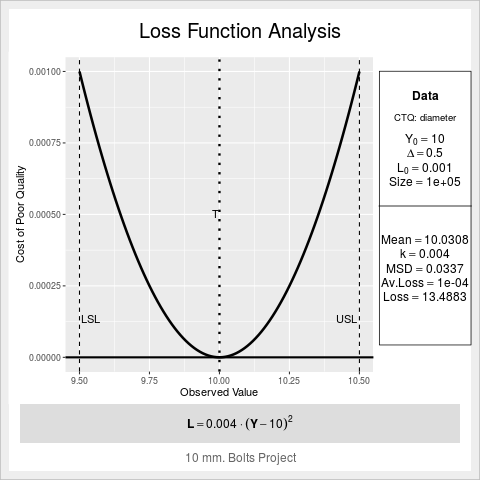Supported by Dr. Osamu Ogasawara and  providing providing  . . |
|
Last data update: 2014.03.03 |
Loss Function AnalysisDescriptionThis function performs a Quality Loss Function Analysis, based in the Taguchi Loss Function for "Nominal-the-Best" characteristics. Usagess.lfa(lfa.data, lfa.ctq, lfa.Delta, lfa.Y0, lfa.L0, lfa.size = NA, lfa.output = "both", lfa.sub = "Six Sigma Project") Arguments
Details
Value
NoteFor smaller-the-better characteristics, the target should be zero ( Author(s)EL Cano ReferencesTaguchi G, Chowdhury S,Wu Y (2005) Taguchi's quality engineering handbook. John
Wiley Cano, Emilio L., Moguerza, Javier M. and Redchuk, Andres. 2012.
Six Sigma with R. Statistical Engineering for Process
Improvement, Use R!, vol. 36. Springer, New York.
http://www.springer.com/statistics/book/978-1-4614-3651-5. See Also
Examplesss.lfa(ss.data.bolts, "diameter", 0.5, 10, 0.001, lfa.sub = "10 mm. Bolts Project", lfa.size = 100000, lfa.output = "both") Results
R version 3.3.1 (2016-06-21) -- "Bug in Your Hair"
Copyright (C) 2016 The R Foundation for Statistical Computing
Platform: x86_64-pc-linux-gnu (64-bit)
R is free software and comes with ABSOLUTELY NO WARRANTY.
You are welcome to redistribute it under certain conditions.
Type 'license()' or 'licence()' for distribution details.
R is a collaborative project with many contributors.
Type 'contributors()' for more information and
'citation()' on how to cite R or R packages in publications.
Type 'demo()' for some demos, 'help()' for on-line help, or
'help.start()' for an HTML browser interface to help.
Type 'q()' to quit R.
> library(SixSigma)
> png(filename="/home/ddbj/snapshot/RGM3/R_CC/result/SixSigma/ss.lfa.Rd_%03d_medium.png", width=480, height=480)
> ### Name: ss.lfa
> ### Title: Loss Function Analysis
> ### Aliases: ss.lfa
> ### Keywords: Taguchi function loss
>
> ### ** Examples
>
> ss.lfa(ss.data.bolts, "diameter", 0.5, 10, 0.001,
+ lfa.sub = "10 mm. Bolts Project",
+ lfa.size = 100000, lfa.output = "both")
$lfa.k
[1] 0.004
$lfa.lf
expression(bold(L == 0.004 %.% (Y - 10)^2))
$lfa.MSD
[1] 0.03372065
$lfa.avLoss
[1] 0.0001348826
$lfa.Loss
[1] 13.48826
>
>
>
>
>
> dev.off()
null device
1
>
|
